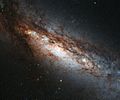Fichier:Hubble Sees a Bizarre Cosmic Rarity (11241869426).jpg

Fichier d’origine (1 280 × 1 065 pixels, taille du fichier : 485 kio, type MIME : image/jpeg)
| Ce fichier et sa description proviennent de Wikimedia Commons. | Accéder au fichier sur Commons |
Description
| DescriptionHubble Sees a Bizarre Cosmic Rarity (11241869426).jpg |
This new Hubble image shows a peculiar galaxy known as NGC 660, located around 45 million light-years away from us. NGC 660 is classified as a "polar ring galaxy," meaning that it has a belt of gas and stars around its center that it ripped from a near neighbor during a clash about one billion years ago.The first polar ring galaxy was observed in 1978 and only around a dozen more have been discovered since then, making them something of a cosmic rarity. Unfortunately, NGC 660’s polar ring cannot be seen in this image, but the image has plenty of other features that make it of interest to astronomers – its central bulge is strangely off-kilter and, perhaps more intriguingly, it is thought to harbor exceptionally large amounts of dark matter. In addition, in late 2012 astronomers observed a massive outburst emanating from NGC 660 that was around ten times as bright as a supernova explosion. This burst was thought to be caused by a massive jet shooting out of the supermassive black hole at the center of the galaxy. Credit: Hubble/NASA/European Space Agency NASA Goddard Space Flight Center enables NASA’s mission through four scientific endeavors: Earth Science, Heliophysics, Solar System Exploration, and Astrophysics. Goddard plays a leading role in NASA’s accomplishments by contributing compelling scientific knowledge to advance the Agency’s mission. Follow us on Twitter Like us on Facebook Find us on Instagram |
| Date | |
| Source | Hubble Sees a Bizarre Cosmic Rarity |
| Auteur | NASA Goddard Space Flight Center from Greenbelt, MD, USA |
Conditions d’utilisation
- Vous êtes libre :
- de partager – de copier, distribuer et transmettre cette œuvre
- d’adapter – de modifier cette œuvre
- Sous les conditions suivantes :
- paternité – Vous devez donner les informations appropriées concernant l'auteur, fournir un lien vers la licence et indiquer si des modifications ont été faites. Vous pouvez faire cela par tout moyen raisonnable, mais en aucune façon suggérant que l’auteur vous soutient ou approuve l’utilisation que vous en faites.
| Cette image a été originellement postée sur Flickr par NASA Goddard Photo and Video à l'adresse https://flickr.com/photos/24662369@N07/11241869426. Elle a été passée en revue le 17 septembre 2016 par le robot FlickreviewR, qui a confirmé qu'elle se trouvait sous licence cc-by-2.0. |
17 septembre 2016
| Public domainPublic domainfalsefalse |
| Ce fichier provient de la NASA. Sauf exception, les documents créés par la NASA ne sont pas soumis à copyright. Pour plus d'informations, voir la politique de copyright de la NASA. |  | |
 |
Attention :
|
Légendes
Éléments décrits dans ce fichier
dépeint
Valeur sans élément de Wikidata
2 décembre 2013
Historique du fichier
Cliquer sur une date et heure pour voir le fichier tel qu'il était à ce moment-là.
| Date et heure | Vignette | Dimensions | Utilisateur | Commentaire | |
|---|---|---|---|---|---|
| actuel | 17 septembre 2016 à 22:49 |  | 1 280 × 1 065 (485 kio) | Vanished Account Byeznhpyxeuztibuo | Transferred from Flickr via Flickr2Commons |
Utilisation du fichier
Les 2 pages suivantes utilisent ce fichier :
Métadonnées
Ce fichier contient des informations supplémentaires, probablement ajoutées par l'appareil photo numérique ou le numériseur utilisé pour le créer.
Si le fichier a été modifié depuis son état original, certains détails peuvent ne pas refléter entièrement l'image modifiée.
| Crédit ou fournisseur | ESA/Hubble & NASA |
|---|---|
| Source | ESA/Hubble |
| Titre court |
|
| Titre de l’image |
|
| Mots-clés | NGC 660 |
| Coordonnées de contact |
http://www.spacetelescope.org/ Karl-Schwarzschild-Strasse 2 D-85748 Garching bei München, Germany |
| Conditions d’utilisation |
|
| Date et heure de génération des données | 2 décembre 2013 à 10:00 |